The Campaign of 1809 in Germany and Austria
day by day
In 1809, Austria, seeing Napoleon I weakened by the war of attrition he was waging in the Iberian Peninsula, considered it opportune to take the initiative to erase the humiliation of Austerlitz and the subsequent Treaty of Pressburg [today Bratislava].
While the Emperor of Austria, Francis I, was massing his troops on the border of Bavaria, Napoleon was gathering a large army there, but less seasoned than the one operating in Spain. It included Bavarians, Württembergians and Badensians belonging to the Confederation of the Rhine [Rheinbund], made up of German satellite states of the French Empire.
On April 9, Austria launched the attack.
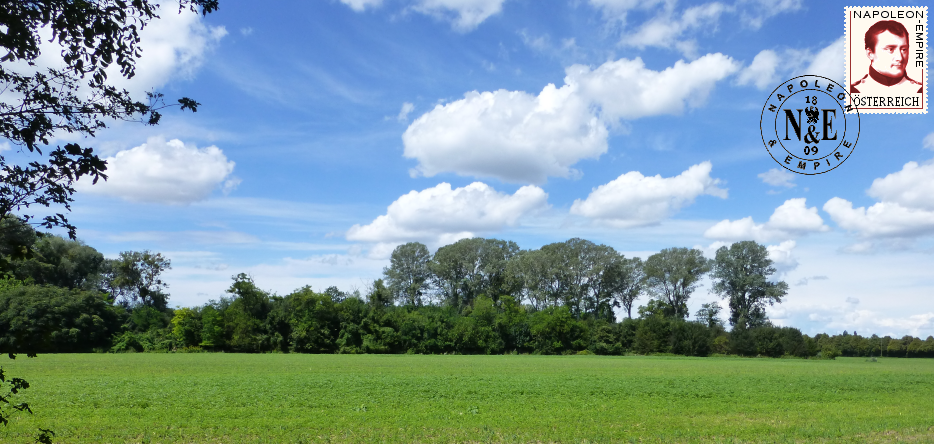
We followed the movements of the Emperor and the Grande Armée day after day, and captured in images the locations of this campaign, in particular the battlefields. While the one at Eckmühl remains well preserved due to its rural character, this is unfortunately not the case for those at Aspern-Essling and Wagram, which have become suburban housing estates of the Austrian capital... We did "the best we could"...
April 1809
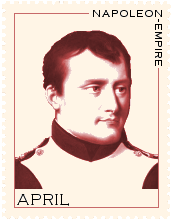
- April 12 - Napoleon learned by telegraph before 8 p.m. that the Austrians had crossed the Inn River on the 9th, which marked the border with the Kingdom of Bavaria: it was war. He therefore decided to leave to join the army. Empress Josephine obtained permission to accompany him.
- April 13 - He left Paris shortly after 4 o'clock in the morning in the company of Joséphine and the mamluk Roustam, passed through Reims , then headed for Bar-le-Duc.
- April 14 - He arrived in the morning at Bar-le-Duc , where he visited Marshal Nicolas-Charles Oudinot.
- April 15 - He arrived at dawn in Strasbourg . Josephine settled in the Rohan Palace , which had the rank of Imperial Palace. Napoleon, for his part, left early in the afternoon by the Kehl bridge in the company of the Grand Marshal of the Palace Géraud Michel Duroc. After inspecting the work on the fortifications of the border town, he headed northeast, passing through Rastadt, then Ettlingen Castle [48.94090, 8.40880] where he received the Grand Duchess Stephanie of Baden. He then turned east-southeast to Durlach, where he spoke with Louis Bignon, chargé d'affaires in Karlsruhe. Two hours later, he continued on to Pforzheim [48.89340, 8.70860] where an envoy from the King of Württemberg was waiting for him.
- April 16 - He arrived at 4 o'clock in Ludwigsburg (some sources say Ludwigshafen, but this city on the banks of the Rhine, 80 kilometers north of Pforzheim, would make him make a detour that is difficult to explain, and the Emperor's correspondence as well as Savary's memoirs do mention Ludwigsburg). There he spoke with King Friedrich Wilhelm Karl von Württemberg . He left at 10:30 for Cannstadt [Bad Cannstatt], 12 kilometers to the south near Stuttgart, where Anne-Jean-Marie-René Savary, Duke of Rovigo joined him. He had lunch at an inn in Schorndorf [48.80434, 9.53127] and then continued eastwards, in torrential rain, to Gmünd [Schwäbisch Gmünd] [48.80000, 9.80000] where he dined incognito in a hotel, before reaching the Grand Relais in Aalen [48.83750, 10.09370] to sleep there.
- April 17 - He set off in a south-east direction, passing through Heidenheim an der Brenz and arriving at Dillingen [48.56667, 10.46667], on the banks of the Danube River [Die Donau] , where he met the Bavarian King Maximilian I who had fled Munich [München]. He then went, still on the left (north) bank of the Danube, to Höchstädt an der Donau [48.61143, 10.56718] and then Donauwörth, which he reached at 6 o'clock in the morning, staying at an inn. Two hours later, he went with General Dominique Vandamme to inspect the city fortifications. He then went to Schellenberg, one kilometer to the northeast [48.72171, 10.78479], and before noon spoke with Marshal Louis Alexandre Berthier who had just arrived, and this until 3 p.m.
- April 18 - After having a conversation at 11 o'clock with Marshal Jean Lannes who had just arrived in turn (from Spain), Napoleon left Donauwerth in the company of Savary, passed through Raïn where he had a bridgehead built over the Lech, then Oberhausen [48.72000, 11.11100], crossed the Danube at Neuburg an der Donau and arrived at Ingolstadt , where he spent the night at the royal castle .
- April 19 - While 50 kilometers (31 miles) further east Marshal Louis-Nicolas Davout was defeating the Austrian vanguard commanded by the Archduke Charles on the battlefield of Teugn and Hausen , Napoleon received Prince Louis of Bavaria (Ludwig Karl August von Wittelsbach), eldest son of King Maximilian I, in Ingolstadt. He then rode to Ziegelstadel [48.65929, 11.64926], 24 kilometers to the southeast, on the other bank of the Danube. From there, he went back up at 6 p.m. to Vohburg Castle [48.77072, 11.61622], still on the right bank of the Danube, where he spent the night.
- April 20 - In the thick fog, he set off at 7:30 a.m. heading east-northeast, crossed Neustadt an der Donau, trotted over the bridge over the Abens, and arrived at 9 a.m. in Abensberg , where he stayed with a certain Xavier Edelhart. To the east and south of this town the Battle of Abensberg was then fought, on hilly and wooded terrain between the Danube to the north, and the rivers Abens to the west and Große-Laaber to the east. Napoleon supervised and directed his troops from the vicinity of Offenstetten [48.80322, 11.90626], then he entered the village of Bachl [48.81047, 11.94642] in the evening, before going to stay at 9 p.m., the battle won, in Rohr in Niederbayern , at the Weinziell brewery, on the Marktplatz [48.76667, 11.96667].
- April 21 - Having slept only two hours, on a chair, Napoleon left at five o'clock to join Marshal Lannes. They passed through Rottenburg an der Laaber, Pfeffenhausen, Holzhausen [48.65132, 11.95551], Weihmichl and Altdorf. It was then a second battle in two days: that of Landshut, on the Isar River , against the Austrian left wing of 36,000 men commanded by General Johann von Hiller . Shortly after noon, Landshut was conquered by the men of General Georges Mouton, and the Emperor went to settle there, at the royal residence [48.53615, 12.15125], a palace built in the first half of the 16th century in the Italian Renaissance style. It was there that he received the news of the capture of Regensburg by the Austrians.
- April 22 - On that day Napoleon fought his third battle in three days, also victorious: the Battle of Eckmühl. Napoleon left Landshut at 9 a.m. in spring-like weather, followed the Isar valley for seven kilometers, then headed north towards Eckmühl [Eggmühl] . Arriving at Ergoldsbach [48.69200, 12.20210] at 11 a.m., he waited for the signal from Marshal Davout (ten cannon shots) to enter the battlefield . He was in Allersdorf [48.80006, 12.12785] when this signal sounded at 13:50. He therefore set off at 14:30, reached Schierling [48.83810, 12.13784], Lindach [48.82792, 12.16430] where he climbed – it is said – into the bell tower of the St. Margaretha church to observe the terrain , then at 17:30 settled on a height at Unterdeggenbach [48.83788, 12.18335] to direct the second phase of the battle. There, General Jean-Baptiste Cervoni was killed by a cannonball to the head while he was at his side [at this precise location was erected in 1909 a mound topped with a monument commemorating the battle]. At 7 p.m. he organized the pursuit and advanced to Alt-Eglofsheim , 11 kilometers to the north, where he spent the first part of the night at the castle and then, due to a fire, in a tent in a village garden.
- April 23 - He left on horseback after 7 o'clock, in a thick fog, towards Regensburg, a city 15 kilometers to the north-northwest. He arrived in front of the city in the morning. Around 2 p.m., while he was examining the ramparts, he was wounded by a bullet in the right foot and was treated by the surgeon Alexandre-Urbain Yvan [a painting by Pierre Gautherot illustrates this event]. He set off again without delay at a gallop, despite the pain, and reviewed the divisions of Louis Charles Vincent Le Blond de Saint-Hilaire and Louis Friant . Once the city had been taken, he established his Headquarters at the monastery St. Vitus of Prüll [Karthaus Prüll] [49.00085, 12.08841], 4 kilometers south of the city walls, and spent the night there. He would stay there on the 24th and 25th.
- April 26 - Having left Regensburg at 8 a.m. by carriage, Napoleon passed through Alteglofsheim and Eckmühl where he visited the wounded, then returned to Landshut, still at the royal palace, where he settled in at 5 p.m.
- April 27 - He left Landshut before noon heading southeast, passed Neumarkt-Sankt Veit [48.36111, 12.50833], was in Mühldorf [48.24556, 12.52278] at 6 p.m., and crossed the river Inn, thus entering Austrian territory.
- April 28 - After having reviewed the light cavalry brigade of General Jacob François Marulaz in Mühldorf, he reached Burghausen, 27 kilometers to the east-southeast, where he arrived at ten o'clock and settled into the Taufkirchen house [current no. 97 of the Stadtplatz] [48.15971, 12.83357]. He would stay there the next day.
- April 30 - He left Burghausen in the evening, crossed the Salzach River [a tributary of the Inn River] during the night and slept in Ranshofen, 4 kilometers before Braunau am Inn, at the castle near the abbey.
May 1809
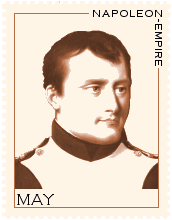
- May 1st - Napoleon arrived in the morning in Braunau am Inn [this Austrian town would later be sadly famous for having been the birthplace of Adolf Hitler in 1889]. He moved into the same house he had occupied in 1805, belonging to a certain Josef Schüde [at the current number 34 Stadtplatz] [48.25752, 13.03537].
- May 2nd - He left Braunau at 7 p.m. heading east, passing through Altheim [48.25036, 13.23271] and Ried im Innkreis [48.21000, 13.48944], and arrived at Lambach at 10 p.m. (these only three hours for a journey of 73 kilometers seem unlikely to us for the era). He spent the night at the Benedictine abbey [Stift Lambach].
- May 3rd - He left Lambach in the morning, crossing the Traun River, and arrived at 10 o'clock in Wels [48.15704, 14.02788] under a violent westerly wind. Hearing the news of the battle of Ebelsberg where Marshal André Masséna was facing the Austrians commanded by General Johann von Hiller, he left for this town where he arrived at the head of General Gabriel Molitor 's division. After having crossed Ebelsberg, he spent the night in a tent in Amstetten, in a garden of the Baumgartner house [Wambacherstrasse 82] [48.23270, 14.32904],, where he worked by candlelight with Pierre-Antoine Daru and Hugues Bernard Maret.
- May 4 - In Ebelsberg, he visited with General Louis Jacques de Coëhorn the battlefield and the famous bridge over the Traun River where the latter's brigade had distinguished itself. He received a deputation of the notables of the town, who presented their grievances to him. Then he reviewed the 26th Line regiment and the Corsican chasseurs. In the afternoon he rode to Enns, dined at the corner of the square and the main street [Wienerstrasse 5] then slept at the Ennsegg castle [Schlossgasse 4] [48.21491, 14.48148] belonging to the Prince of Auersperg, where he would stay until May 7.
- May 5 - He reviewed the Molitor and Carra Saint-Cyr divisions. Before noon he climbed into the church tower – or the belfry [Stadtturm] – to observe the march of the troops towards Amstetten.
- May 7 - Napoleon left Enns by carriage, to go to the Benedictine abbey of Moelk [Stift Melk] [48.22694, 15.34389], 75 kilometers further east, where he spent the night.
- May 8 - He left Melk abbey to go to that of Sankt Pölten [48.20575, 15.62696], former monastery of the regular canons of Saint Augustine which since 1785 had become the seat of the bishopric, 25 kilometers further east. He would stay there the next day.
- May 10 - He left Sankt Pölten at 4 a.m. by car, in thick fog, still heading east. He passed (according to some sources) through Sieghartskirchen [48.25561, 16.01237] and, at 9 a.m., was in Weidlingau [48.21139, 16.22111], in front of Vienna. In the evening, he slept at the Schönbrunn Palace , the summer residence of the ruling family of Austria. He stayed there until May 18.
- May 11 to 16 - Napoleon received deputations, carried out inspections and troop reviews.
- May 17 - The Emperor decided by decree to annex the Papal States to the French Empire to form the departments of Tibre and Trasimène.
- May 18 - After having written to Maria Walewka asking her to join him, Napoleon left Schönbrunn heading east to Kaiser-Ebersdorf, where he arrived around 5 p.m. and settled into the outbuildings of a brewery [now Schloß-Restaurant Thürnlhof] [48.15823, 16.47594] not far from the castle [48.15932, 16.47371].
- May 19 and 20 - At Schwechat, on the right (south) bank of the Danube, Napoleon supervised the construction of a pontoon bridge over the main branch of the river, which led to the island of Lobau.
- May 21 - It was the first day of the terrible battle of Aspern-Essling. The Emperor held a council with Marshal Berthier in the ruins of the old Essling castle [48.21480, 16.52277], then stood to the left of the tile factory [around 48.20463, 16.49597]. There he was superficially wounded in the left leg by a gunshot.
- May 22 - Second day of the Battle of Aspern-Essling. Napoleon left the bivouac on Lobau iIsland [48.18069, 16.49057] at 6 o'clock for the tile factory, where he remained until half past twelve. He then left for Stadts Enzersdorf [Groß-Enzersdorf] [48.20108, 16.55060], along the Danube. He saw Marshal Lannes wounded, then visited him after the operation carried out by Dominique-Jean Larrey. After holding a council of war, he crossed the Danube on a boat [this crossing would be illustrated by Anton Freiherr von Perger in 1845 ] and spent the night at Kaiser-Ebersdorf.
- May 23 - Napoleon resided in Kaiser-Ebersdorf, where he would stay until June 4.
- May 30 - He visited Jean Lannes who had been installed in one of the houses in the village, for a final interview with the man he considered a friend.
- May 31 - He learned in the morning of the Marshal's death, and went in the afternoon to pay his respects to his remains.
June 1809
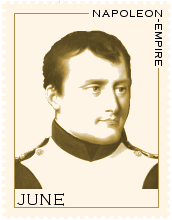
- June 1st - Napoleon left Ebersdorf for the Schönbrunn Palace, where he would reside until the end of the month.
- June 7 - He went to Neustadt [Wiener Neustadt] [47.81320, 16.24431], 50 kilometers south of Schönbrunn, to review the Army of Italy.
- June 8 to 24 - He went every afternoon to Lobau Island to monitor the preparations for the new battle that was coming.
- June 30 - In the evening, learning that General François Roch Ledru des Essarts, who commanded the vanguard brigade of Masséna's corps, had been able to cross the Danube facing Essling, he decided to set off the next morning.
July 1809
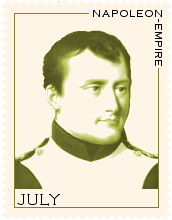
- July 1st - Early in the morning, Napoleon left Schönbrunn for the recently built bridges of Ebersdorf, then went to inspect the observatory that had just been established opposite Essling, as well as the batteries on Lobau Island.
- July 2nd - He reviewed the large artillery park, and studied the maneuver for the upcoming confrontation.
- July 3rd - New inspections.
- July 4 - During the storm, Napoleon went to Montebello Island (also called Lannes Island) [48.19722, 16.54007] around 10 p.m., and while the Grande Armée crossed the northern arm of the Danube on three bridges launched from the east coast of Lobau Island, he witnessed the bombardment of the village of Enzersdorf .
- July 5 - This was the first day of the Battle of Wagram. Napoleon remained at his headquarters set up in the center of the battlefield, north of Raasdorf [48.26846, 16.55839] .
- July 6 - Second day of the Battle of Wagram. The Emperor crisscrossed the battlefield: Großhofen , Glinzendorf , the banks of the Rüssbach , Baumersdorf [now Parbarsdorf] , Aderklaa , then ended the day at his headquarters.
- July 7 - After reviewing the troops of Marshal Etienne Macdonald, Napoléon went to Gross Ebersdorf [48.36234, 16.46916] then to Wolkersdorf, 30 kilometers further north, where he stayed at the imperial castle [48.38110, 16.51910].
- July 8 and 9 - He stayed in Wolkersdorf, suffering from digestive problems.
- July 10 - He left Wolkersdorf in the early morning, heading north for Wilfersdorf [48.58779, 16.64539] then Laa an der Thaya [48.71871, 16.38738], which he reached at 6 p.m. and where he stayed at the village priest's house.
- July 11 - Napoleon left Laa before sunrise, and headed towards Znaim [nowadays Znojmo, in the Czech Republic] , about thirty kilometers to the northwest, where a battle had been going on since the day before between the Austrian forces of Archduke Charles and the Army of Dalmatia of General Auguste Frédéric Viesse de Marmont, reinforced since the morning of the 11th by Marshal Masséna, at the head of the IVth Corps and a battery. The Emperor settled on the plateau of Zuckerhandl [Suchohrdly] , which overlooked the city to the northeast of it. In the evening the Austrians proposed a suspension of hostilities, which Napoleon accepted.
- July 12 - Napoleon travelled to Hödnitz [Hodonice], a few kilometers further east [48.83552, 16.16853], where he stayed in a house on Church Street.
- July 13 - After receiving an Austrian delegation, Napoleon left at 9 a.m. for Schönbrunn, passing through Leopoldau and Spitz, crossing the Danube River on a pontoon bridge, and stopping at the Prater [48.192536, 16.43900] before reaching the palace. The 1809 campaign ended as far as its military phase was concerned.
- July 14 and beyond - Napoleon would reside at Schönbrunn until October 16, when he would begin his return to Fontainebleau, where he would arrive on the 26th of the month.
 All of Napoleon's movements from 1769 to 1821
All of Napoleon's movements from 1769 to 1821
Photos credits
Photos by Lionel A. Bouchon.Photos by Didier Grau.
Photos by Michèle Grau-Ghelardi.
Photos by Marie-Albe Grau.
Photos by Floriane Grau.
Photos by various authors.